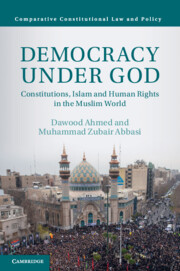Book contents
- Democracy Under God
- Comparative Constitutional Law and Policy
- Democracy Under God
- Copyright page
- Brief Contents
- Detailed Contents
- Figures
- Tables
- Preface
- Acknowledgments
- Note on Translation, Transliteration, and Citations
- Introduction
- Part I
- 1 Islamic Constitutionalism
- 2 What is an Islamic Constitution?
- Part II
- Part III
- Bibliography
- Index
1 - Islamic Constitutionalism
Origins and Present
from Part I
Published online by Cambridge University Press: 23 February 2023
- Democracy Under God
- Comparative Constitutional Law and Policy
- Democracy Under God
- Copyright page
- Brief Contents
- Detailed Contents
- Figures
- Tables
- Preface
- Acknowledgments
- Note on Translation, Transliteration, and Citations
- Introduction
- Part I
- 1 Islamic Constitutionalism
- 2 What is an Islamic Constitution?
- Part II
- Part III
- Bibliography
- Index
Summary
Chapter 1 introduces the theory of Islamic constitutionalism and examines the popularity of Islamic constitutional clauses in political life and how they originated along with constitution making in the Muslim world. It describes the constitutional history in four monarchies: Tunisia, the Ottoman Empire, Egypt, and Iran. The chapter demonstrates that the idea of "Islamic constitutionalism" itself originated in parallel to, and not in isolation from, the idea of modern European "constitutional democracy," beginning with the Ottoman and Persian "constitutions" of the mid-nineteenth and early twentieth centuries, respectively, partly as a defense mechanism in the face of ubiquitous "Europeanization" of politics. As such, it traces how and why, in an era of European colonial domination, the constitution becomes the focal point in the state where the negotiation or balancing between "Islam" and "liberal" democracy takes place. It is thus the starting point for realizing the twin popular ambitions – of rights and Islam.
- Type
- Chapter
- Information
- Democracy under GodConstitutions, Islam and Human Rights in the Muslim World, pp. 13 - 25Publisher: Cambridge University PressPrint publication year: 2023

